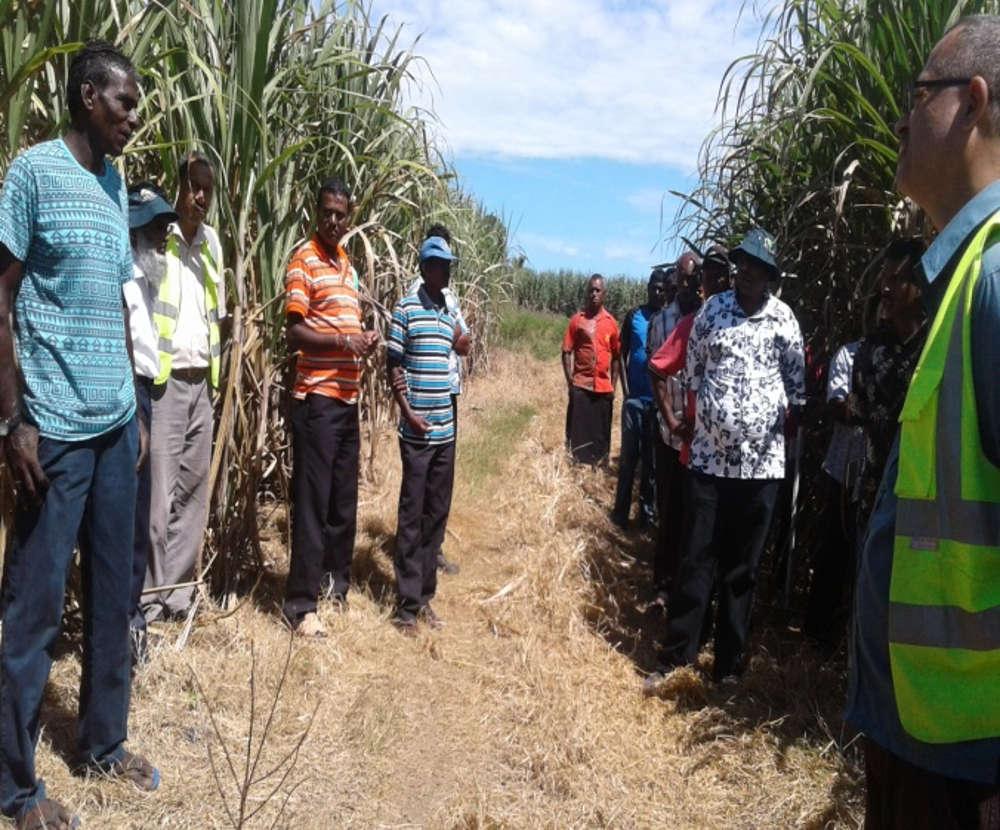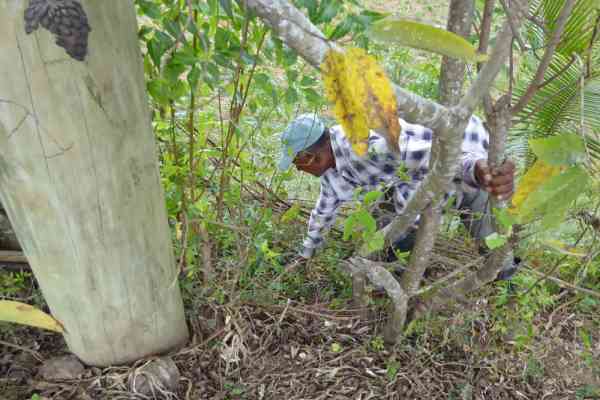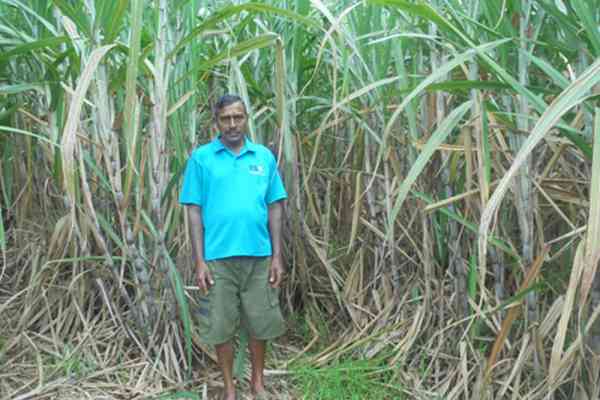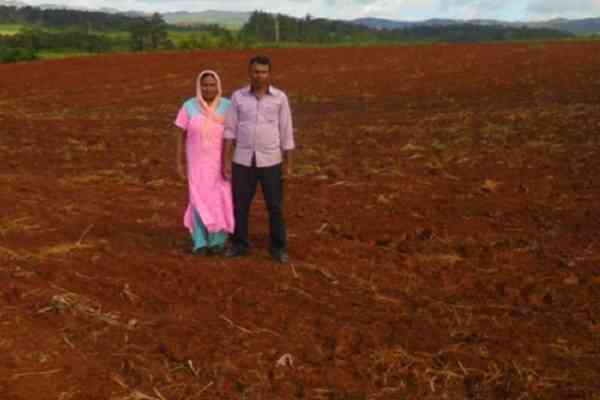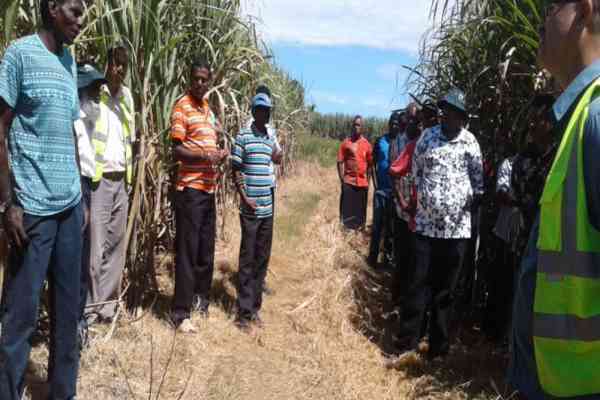Bal Ram (far left) shows other Leader Farmers from Tavua around his farm while explaining his changed farming techniques
Bal Ram is a 49 year-old cane farmer from Tagitagi, Tavua. His farm lies in a particularly dry area, with undulating terrain and poor soil. Bal Ram’s grandfather and father were also cane farmers and he learnt about cane farming as a child while helping his elders on the farm. At the age of 17, he started farming for himself, but he did not let this compromise his education and completed his secondary education while taking care of his farm.
Bal Ram and his four brothers who live nearby, have three cane contracts and work together to share the workload. In 2014, Bal Ram bought a Massey 135 tractor and equipped it with the necessary farm implements. Since then he no longer uses bullocks to prepare the land.
In 2015, Bal Ram participated in a training course on “Best Practices in Cane Husbandry” offered by the European Union (EU) funded Fairtrade Project. Here, he learned about new cane farming practices which could help him increase his production while taking better care of the farm environment. Later, he joined in project training on Leadership and Communication as well as on Farming as a Business. These training sessions prepared Bal Ram to become a Leader Farmer. Working together with the Fiji Sugar Corporation (FSC) field team he chose a group of 13 farmers in his neighbourhood, who became his Link Farmers and to whom he now passes on the knowledge and skills learned through his training, and with whom he exchanges experiences in cane farming. The group is known as the Farmer Field School. Bal Ram demonstrates the new practices on his own farm.
Bal Ram is a prominent member of his community. He serves on committees of the Tagitagi Sangam School, Tagitagi Cemetery, Tagitagi Temple and the soccer club. He is also known by his community as a serious farmer with much knowledge. He takes good care of his cane by ensuring that his fields are fertilised and weeded at exactly the right time. He also takes care of his soil by intercropping his cane fields with cowpeas. The cowpeas provide nitrogen to the soil which will be used by the next crop of cane to grow strong and healthy.
Bal Ram has a corner of one field dedicated to a cane nursery. He got the idea during his training. Often, it is very difficult to come by seed cane when needs are high; it is also quite expensive to transport. Bal Ram therefore decided to produce his own. His decision has already paid off and shown to improve his resilience in difficult times. After Tropical Cyclone (TC) Winston struck his community, Bal Ram was able to quickly plant three acres of cane just by using the cane in his nursery. Of course the cane in his nursery had also been damaged by the strong winds, but it was good enough for use as seed cane. Unlike other farmers, he did not have to waste time and money searching for new seed cane and as a result, he recovered from TC Winston quicker.
The three acres that he planted immediately after the cyclone have produced a beautiful crop. Bal Ram usually has enough seed cane to share with those in need; and he doesn’t ask for payment. But he does tell other farmers to start their own nurseries, so that they become more independent. It is this kind of leadership that other farmers admire in Bal Ram.
"Bal Ram ", "Farmer from Tagitagi, Tavua", "Fiji"
“Sugarcane has always been the first income source for the people of my village. And it can stay that way. Our children have to learn about sugarcane cultivation. Of course, they must go to school and educate themselves, but when they become farmers they must not stop learning. Farming changes all the time. If farmers keep on learning they can keep on growing sugarcane. And I am helping in that.”
Until last year, Bal Ram cultivated only one variety of cane, the traditional “Mana” variety. Mana cane was grown by his father and his grandfather before him. It is a hardy cane, well-suited to Bal Ram’s area which receives low rainfall with a high level of unpredictability.
However, in 2016 Fairtrade project staff discussed the possibility of growing other cane varieties. This would further improve Bal Ram’s resilience in the event that a disease might affect his Mana.
Bal Ram was quickly convinced. He worked with project staff to establish a demo plot on his farm. In it they planted the new variety called “LF91”. This cane was developed by the Sugar Research Institute of Fiji (SRIF). It matures early and should be harvested between July and September; it also has a high sugar content, grows well on most soils and has yields similar to Mana.
Now, a year later, the LF91 has grown well in Bal Ram’s field and this has surprised him. “I thought Mana was the only variety suitable to be grown on my farm. I am really very satisfied when I look at my crop.” He will be harvesting shortly and looks forward to knowing how much the yield is so that he can compare it with his Mana. In fact, Bal Ram is looking forward to harvesting 250 tons of cane from his whole farm this year. It is a massive jump from the 30 tons of cane he harvested in 2016 which had suffered from two consecutive years of below-average rainfall followed by TC Winston. Collectively, Bal Ram and his brothers estimate a harvest of 750 tons of cane this year. Their ability to stick together has enabled the family to bounce back strongly after difficult years.
Bal Ram says that the Farmer Field School is a good way of sharing knowledge with many other farmers and spreading the message. He doesn’t stop with his Link Farmers, he also freely shares his knowledge with other interested famers in his community.
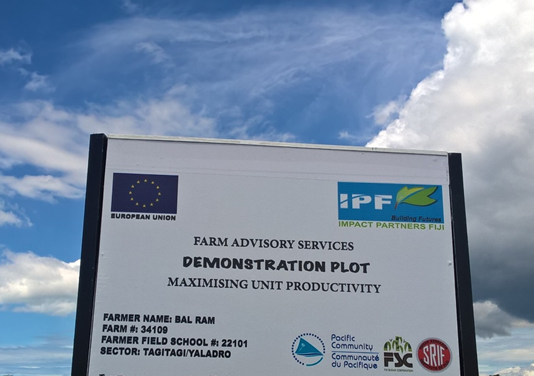
Signage at Bal Ram's demonstration plot
